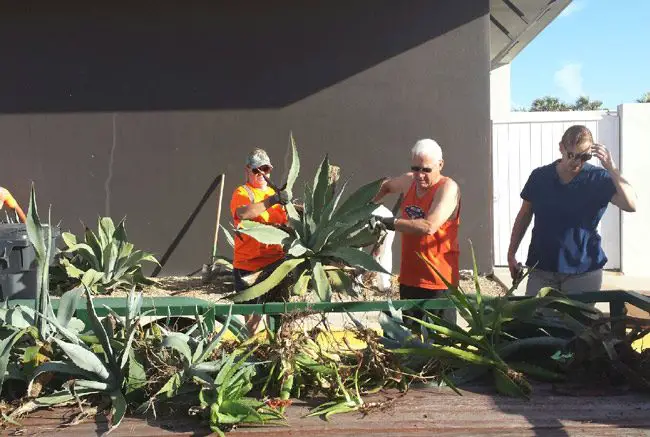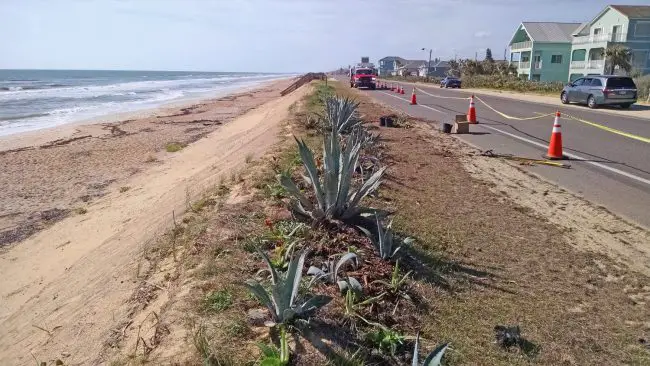
If anyone wants to volunteer and be on the adopt-a-dune plant digs, or if people have plants they want to either drop off or allow to be uprooted from in front of their properties, call Flagler Beach City Hall at 517-2000 and press 0 to connect to any of the staffers: they’re coordinating the effort.
![]()
Earlier this month the state Department of Transportation asked Flagler Beach police to crack down on enthusiasts of rock art along the south end of A1A. People had taken to using rocks from the new revetments, installed there after the emergency reconstruction of A1A, to build rock towers, some of them rising two to three feet, all of them together creating an aesthetic contrast with the brutal drabness of the revetments.
But a day after reading about rain damage along A1A, when rivulets of stormwater excavated their way to the ocean through canyons in the emergency wall, the transportation department blamed it on the rock art. The city did not crack down, exactly: City Manager Larry Newsom said he wasn’t going to unleash police against rock-art builders, but merely educate residents and visitors to help the city maintain the integrity of the revetments. So it’s been.
Last week and this week, however, a group of Flagler Beach volunteers led by City Commissioner Joy McGrew are going a step further. They are turning a couple of blocks of shoreline at the north end of State Road A1A into a pilot project. The volunteers, many of them from the Aliki condominiums, are uprooting plants from in front of their building and replanting them on the dunes with two goals in mind: to keep people from using the dunes as walk-overs down to the beach, and to create some erosion control.
Call it Adopt-A-Dune.
“We’re trying to create a barrier line that makes people not be able to physically break through that line and walk through the dunes and down to the beach,” McGrew said. “There’s no walkover, so I understand the frustration.” But, the commissioner said, people must understand that the stability of the dunes comes first: plants give them some of that stability and protection. “We don’t want to keep them from going to the beach, we just want to help us preserve the dunes and understand.”
And none of it is costing a dime.
The city lost many walkovers during Hurricane Matthew. The problem is especially acute at the north end on long blocks that [provide no access to the beach. There is a functioning walkover at North 21st Street, and another functional one at North 23rd. People have been using the dunes to cross over in between. “We know how people are, and we know that people are going to take the path of least resistance,” McGrew said.

That’s what the replanting is intended to stop, along 22nd Street.
Last Thursday, McGrew and the Aliki group, joined by Commissioner Marshal Shupe and a few city employees, who provided a water truck and some manpower, dug up plants from in front of the Aliki condominium, put them on a flatbed truck and planted them along the dunes.
They’re the sort of plants that grow typically in that environment—aloe plants, prickly pear, dune daisies, century plants, the sort of plants “that are going to poke,” and “make you bleed,” McGrew said. “We’re trying to use plants that are within the area, the actual locale where we’re working.”
Meanwhile the city has been working on adding five walkovers—two at the north end, including between 20th and 23rd streets, and three at the south end, City Manager Larry Newsom said, between the areas of South 13th and South 18th, and at South 27th Street. Work on the South 27th walkover could start this week, Newsom said.
Those walkovers may again be removed in 18 months, when the state Transportation Department begins construction on the permanent replacement of State Road A1A. That project is in its design phase.
In addition to the replanting initiatives, Newsom said residents may see some “post-and-rope” fencing along the dunes as added protection: it’s a reminder, which volunteers are stressing, not to park on the grass and the vegetation east of A1A, and of course not removing the plants there.
McGrew, who is working on the A1A “prototypes,” as she calls them, with people including LeighAnn Koch and Mary Louk, said the group is looking for property owners along A1A willing to have the plants in front of their homes dug up and transported to dune locations.
Next Thursday, the group will conduct another plant day in front of Turtle Shack and in front of Java Joint, again at the north end of town.
If anyone wants to volunteer and be on the adopt-a-dune plant digs, or if people have plants they want to either drop off or allow to be uprooted from in front of their properties, call Flagler Beach City Hall at 517-2000 and press 0 to connect to any of the staffers: they’re coordinating the effort.
![]()

(© Joy McGrew for FlaglerLive)





























Tony says
Did Flagler Beach Commissioner Marshal Shupe obtain all the required permits, notify the Florida Department of Environmental Protection of the alterations to the Dunes.
Were the plants used approved and recommended by the Florida Beach and Dune plant guidelines.
And did he, CALL 811 BEFORE YOU DIG
Richard Smith says
Great Job gang! Looks pretty but a far cry from being truly functional protection for the dunes. Another severe storm or heavy rain will ravish the dunes once again which will come at anytime. Flagler Beach and the powers at be are dragging their feet on this so get ready to re-plant what you guys have just completed in a valor attempt to restore the dunes.
Lazaruis says
Great I saw it today !!
Shame the city/county can’t do it .
Thank you !!
Ms. Auggie says
ONE MORE TIME!!!!
NOBODY has Contacted The University of Florida,
FOR FROZEN SEA OAT SEEDS.
THE ONLY WAY— TO REBUILD DUNES , IS TO REPLANT WHAT KEPT THM THERE!!!!!!!!!
SEA OATS and VINES, Whos ROOTS Keep The Grains of Sand bEHIND THEM !
BOTH INDIGINOUS- TO THESE BEACHES
! DUHHHHH
Steve Wood says
Now the city needs to ENFORCE people walking on the dunes and also stealing the plant life that us already along the dunes. Hope it works or A1A will be Central so people and the PD to take care of it.
Diane says
So can anyone go plant on the dunes ?
What department in the county is in charge of caring for these plants that “make you bleed ” ?
NaturesGreat says
Valiant effort, but it will not stop nature. Lets not forget 65 million years ago, Florida was for the most part completely underwater. I equate a grown-up who thinks he or she can stop the ocean’s ability to shape our coastlines to the likes of a little tyke who builds a sturdy, hand-patted, sand wall around his or her castle by the sea. Eventually, no matter how big or elaborate of a wall, the sea’s waves win. I hate to say this, but that dune will just not stop a few more minor hurricanes and it’s not the ocean’s fault, that’s what oceans do – they move and shape coastlines!!!!
Sw says
Plant marijuana to restore the dunes. Dual purpose.
LSKOCH5 says
@SteveWood – you’re so right, but people also need to be educated about the importance of keeping off the dunes. Once their feet trod through the dunes, they’ve begun the erosion process. The plants are vital, & we’re always amazed to see people digging up dune vegetation that is protected by local, state, & federal law.
This is silly. says
Build a sea wall and be done with it. This is a waste of time and money.